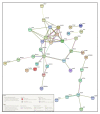Uncovering Potential Roles of Differentially Expressed Genes, Upstream Regulators, and Canonical Pathways in Endometriosis Using an In Silico Genomics Approach
- PMID: 32575462
- PMCID: PMC7344784
- DOI: 10.3390/diagnostics10060416
Uncovering Potential Roles of Differentially Expressed Genes, Upstream Regulators, and Canonical Pathways in Endometriosis Using an In Silico Genomics Approach
Abstract
Endometriosis is characterized by ectopic endometrial tissue implantation, mostly within the peritoneum, and affects women in their reproductive age. Studies have been done to clarify its etiology, but the precise molecular mechanisms and pathophysiology remain unclear. We downloaded genome-wide mRNA expression and clinicopathological data of endometriosis patients and controls from NCBI's Gene Expression Omnibus, after a systematic search of multiple independent studies comprising 156 endometriosis patients and 118 controls to identify causative genes, risk factors, and potential diagnostic/therapeutic biomarkers. Comprehensive gene expression meta-analysis, pathway analysis, and gene ontology analysis was done using a bioinformatics-based approach. We identified 1590 unique differentially expressed genes (129 upregulated and 1461 downregulated) mapped by IPA as biologically relevant. The top upregulated genes were FOS, EGR1, ZFP36, JUNB, APOD, CST1, GPX3, and PER1, and the top downregulated ones were DIO2, CPM, OLFM4, PALLD, BAG5, TOP2A, PKP4, CDC20B, and SNTN. The most perturbed canonical pathways were mitotic roles of Polo-like kinase, role of Checkpoint kinase proteins in cell cycle checkpoint control, and ATM signaling. Protein-protein interaction analysis showed a strong network association among FOS, EGR1, ZFP36, and JUNB. These findings provide a thorough understanding of the molecular mechanism of endometriosis, identified biomarkers, and represent a step towards the future development of novel diagnostic and therapeutic options.
Keywords: biomarker; canonical pathways; endometriosis; microarray; transcriptomics.
Conflict of interest statement
The authors declare no conflict of interest.
Figures






Similar articles
-
Bioinformatics approach reveals the key role of C‑X‑C motif chemokine receptor 2 in endometriosis development.Mol Med Rep. 2018 Sep;18(3):2841-2849. doi: 10.3892/mmr.2018.9275. Epub 2018 Jul 12. Mol Med Rep. 2018. PMID: 30015967 Free PMC article.
-
Analysis of key candidate genes and pathways of endometriosis pathophysiology by a genomics-bioinformatics approach.Gynecol Endocrinol. 2019 Jul;35(7):576-581. doi: 10.1080/09513590.2019.1576609. Epub 2019 Feb 23. Gynecol Endocrinol. 2019. PMID: 30798642
-
In search of key genes associated with endometriosis using bioinformatics approach.Eur J Obstet Gynecol Reprod Biol. 2015 Nov;194:119-24. doi: 10.1016/j.ejogrb.2015.08.028. Epub 2015 Aug 28. Eur J Obstet Gynecol Reprod Biol. 2015. PMID: 26366788
-
Systematic enrichment analysis of microRNA expression profiling studies in endometriosis.Iran J Basic Med Sci. 2015 May;18(5):423-9. Iran J Basic Med Sci. 2015. PMID: 26124927 Free PMC article. Review.
-
Biomarker identification for endometriosis as a target for real-time intraoperative fluorescent imaging: A new approach using transcriptomic analysis to broaden the search for potential biomarkers.Eur J Obstet Gynecol Reprod Biol. 2023 Sep;288:114-123. doi: 10.1016/j.ejogrb.2023.07.007. Epub 2023 Jul 19. Eur J Obstet Gynecol Reprod Biol. 2023. PMID: 37506597 Review.
Cited by
-
Identification and validation of M2 macrophage-related genes in endometriosis.Heliyon. 2023 Nov 11;9(11):e22258. doi: 10.1016/j.heliyon.2023.e22258. eCollection 2023 Nov. Heliyon. 2023. PMID: 38058639 Free PMC article.
-
Exploring the therapeutic potential of H1-antihistamines in endometriosis-A gene regulation-based perspective.Front Med (Lausanne). 2025 Jul 17;12:1538368. doi: 10.3389/fmed.2025.1538368. eCollection 2025. Front Med (Lausanne). 2025. PMID: 40747097 Free PMC article.
-
What Do the Transcriptome and Proteome of Menstrual Blood-Derived Mesenchymal Stem Cells Tell Us about Endometriosis?Int J Mol Sci. 2022 Sep 29;23(19):11515. doi: 10.3390/ijms231911515. Int J Mol Sci. 2022. PMID: 36232817 Free PMC article.
-
The Lipocalin Apolipoprotein D Functional Portrait: A Systematic Review.Front Physiol. 2021 Oct 7;12:738991. doi: 10.3389/fphys.2021.738991. eCollection 2021. Front Physiol. 2021. PMID: 34690812 Free PMC article.
-
Litter Size of Sheep (Ovis aries): Inbreeding Depression and Homozygous Regions.Genes (Basel). 2021 Jan 18;12(1):109. doi: 10.3390/genes12010109. Genes (Basel). 2021. PMID: 33477586 Free PMC article.
References
-
- Rouzi A.A., Sahly N., Kafy S., Sawan D., Abduljabbar H. Prevalence of endometriosis at a university hospital in Jeddah, Saudi Arabia. Clin. Exp. Obstet. Gynecol. 2015;42:785–786. - PubMed
Grants and funding
LinkOut - more resources
Full Text Sources
Research Materials
Miscellaneous

